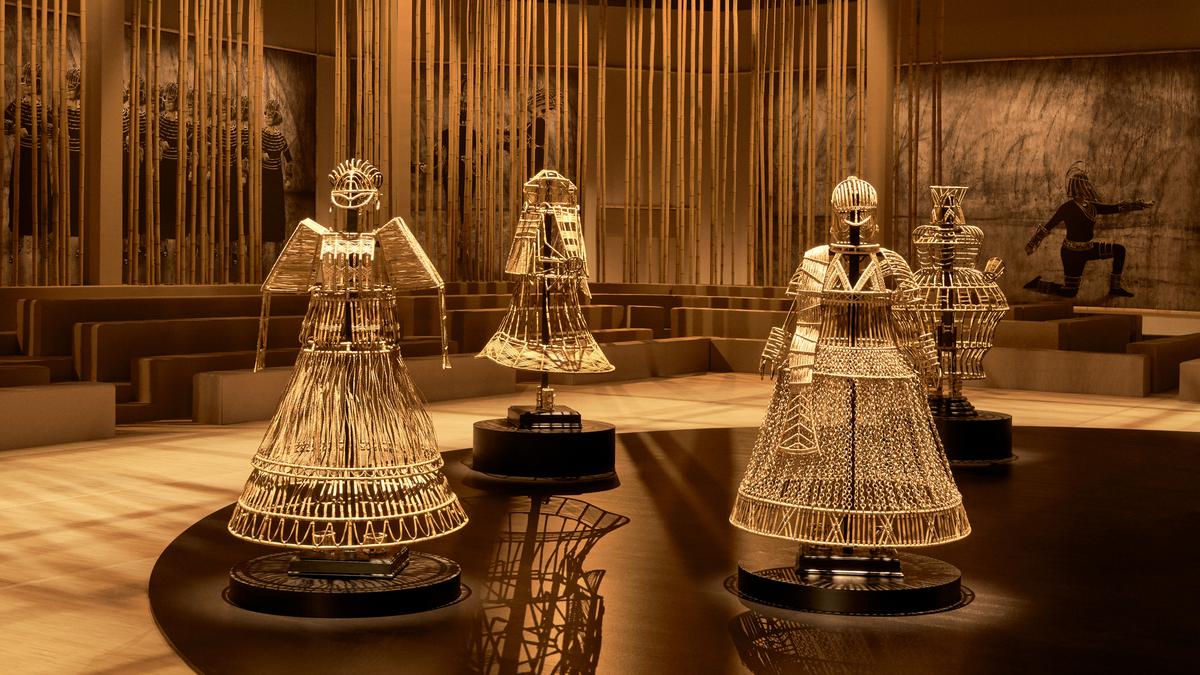
Shakuntala Kulkarni’s armoured Dior runway
The Hindu
The Mumbai-based multimedia artist’s collaboration with the fashion house has once again brought the focus back to body politics
On February 27, at Paris Fashion Week, Dior went back to the 60s. But instead of leaning into its ‘swinging’ tag, creative director Maria Grazia Chiuri had her models wend their way around life-size, cage-like cane forms. Crafted by Mumbai-based artist Shakuntala Kulkarni, the commanding pieces placed at the centre of the runway in Tuileries Garden brought to mind many things: ancient carapaces, imposing samurai yoroi (armour), but also a sense of strength.
While Chiuri’s Fall/Winter 2024-2025 collection focused on the decade of liberated fashion — a transitional era that brought with it the duality of classic fashion and ready-to-wear — Kulkarni’s sculptures offset it perfectly with its symbolised dichotomy of notions of protection and restricted movement. “We were speaking about women’s empowerment and freedom,” says the multimedia artist, 74. “Maria was looking at the new woman and so was I, or rather the possibility of who she could become. Strength and energy, grace and dignity. Maria used fabric and I used cane as fabric to protect.”
As the world takes notice of Kulkarni’s 12-year questioning of women’s body politics, she tells the Magazine about the collaboration with the French fashion house and why the message of her cane armour is always important.
One of Dior’s directors walked into Chemould Prescott Road some time in March or April last year, during my exhibition Quieter than Silence - Compilation of Short Stories. He saw my catalogues of Juloos [a four-screen video installation created in 2015] and Of Bodies, Armour and Cages, and gave it to Maria Grazia Chiuri. When I had a conversation with Maria, I realised that we were both speaking about women’s empowerment and freedom. She was looking at the new woman and so was I — or rather the possibility of who she is, of who she could become. I love movement; I use body language in my films and installations. Hence, the models walking in choreographed movements appealed to me. It was a great experience working together and an opportunity to create an installation in a huge space.
I come from a very open and forward-looking family. I experienced no restrictions till I went to college. Out in the world, however, I experienced discrimination — through personal and shared experiences, through literature, through theatre and films. I saw how this creates fear, discomfort and anxiety for women, sometimes subtly and sometimes loudly. I started inquiring into the violation of the female spaces both in private and public. Theatre has been a huge influence on my work. Hence, I started inviting my viewers to participate in the work, and experience the fear or discomfort women experience within society, which is essentially patriarchal. I have used my body as a site to express all this through video performances, photo performances, live performances, installations, drawing and later by using cane for the armour.
Once, when I was walking in a crowded place in Mumbai, drops of tar fell on me and burned parts of my body. It triggered the notion of protection in public spaces. I was also reading about the rapes in India, and I felt responsible to address it. Thus, the notion of protecting the body from atrocities and violence came up. I designed the armour in such a way that it was a metaphor for protection even as it trapped the body within its cage-like structure. Marriages are supposed to protect a girl, but sometimes atrocities are committed against her. There are honour killings, dowry deaths, consumption, objectification. These are just a few examples to clarify why the armour is used as both protection and as a cage for trapping the female body within the patriarchal society.
I have always loved cane. It is from a creeper family that looks delicate, but it is tenacious. When joined by cane thread, it is flexible; it can be bent and twisted when it is heated. It is also monochromatic with shades of black that are interesting.

Thomas Jefferson and Abraham Lincoln are two of the greatest presidents that the U.S. has seen. You probably know that already. But did you know that Jefferson made what is considered the first contribution to American vertebrate paleontology? Or that Lincoln is the only U.S. president to receive a patent? What’s more, both their contributions have March 10 in common… 52 years apart. A.S.Ganesh hands you the details…












